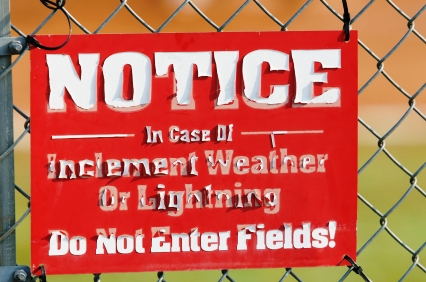Lightning is the most dangerous and frequently encountered thunderstorm hazard that people experience every year, consistently ranking among the top 2 causes of storm-related deaths in the United States. A 2013 position statement from the National Athletic Trainer's Association contains comprehensive recommendations about ways to minimize risk and incidence of injury. (1)

"All individuals, particularly those who are in charge of sports and recreational activities, should be aware of the hazards, establish and follow appropriate guidelines and ensure that those around them do so," said Katie Walsh, EdD, ATC, East Carolina University, who chaired the position statement writing group. "Proper preparation and notifying participants of lightning danger is critical."
Key statistics
During the last decade, lightning has caused an average of 42 fatalities yearly in the U.S. and an estimated 10 times as many injuries.
Data from 2005 indicated that approximately 15 percent of lightning casualties occurred during organized sports and an additional 25 to 30 percent resulted from recreational activities, but more recent data from 2010-2011 by the National Weather Service suggests that these percentages are much higher, with 48 percent and 62 percent of lightning fatalities attributed to sport and recreation, respectively.
During the last decade, lightning was responsible for an average of 42 fatalities yearly in the U.S. and an estimated 10 times as many injuries. There have been 21 reported lightning fatalities so far in 2015, according to the National Oceanic and Atmospheric Administration (NOAA), which represents the highest recorded fatality rate since 2010, when 22 lightning-related deaths were reported in the same time frame. (In the same period in 2014, NOAA only reported 17 deaths attributed to lightning)
For more lightning statistics and facts, click here.
8-point lightning safety plan
The NATA's position statement encourages proper lightning safety policies for coaches, athletic trainers, parents, administrators and others involved in athletic or recreational activities through implementation of an 8-point plan:
1. Establish a lightning-specific emergency action plan. Formalize and implement a comprehensive pro-active emergency action plan (EAP) specific to lightning safety which is rehearsed annually and includes:
- Promoting National Weather Service lightning safety slogans such as "No Place Outside is Safe When Thunderstorms are in the Area" or "Half an Hour Since Thunder Roars, Now it's Safe to Go Outdoors."
- Establishing a chain of command that identifies a specific person to make decisions to remove individuals from the field.
- Using a reliable means of monitoring the local weather.
- Identifying safe locations from lightning hazard in advance of events, such as a building where people live or work or a fully enclosed space (or car). Be aware of unsafe locations such as shelters, picnic tables or bus stops, which are partially open to the elements. Other unsafe venue such as towers or trees can also be targets for lightning. Know how long it will take to get to the safe venues and plan accordingly.
- Identifying specific criteria for suspending and resuming activity, and allow time for evacuation of the premises. Activities should be suspended until 30 minutes after the last lightning strike or sound of thunder.
2. Ensure lightning and general weather awareness: Recognizing and avoiding the lightning hazard is of utmost importance.
- Use a designated weather watcher to be actively looking for signs of approaching or developing local thunderstorms, such as high winds, darkening clouds, or lightning and thunder.
- Use the National Weather Service to monitor local weather before and during outdoor events (note, however, that the NWS does not regularly issue lightning warnings in all locations, nor does it necessarily broadcast information on specific storms).
- Organizers, particularly of larger events, should watch the skies for approaching or locally developing thunderstorms and obtain continual updates on the local weather from electronic media, including NOAA.
- Consider subscribing to a commercial, real-time lightning detection service that has been independently verified so you can determine how far away a storm is and when it is best to go inside. As of 2012, 3 major providers of these lightning-detection services are available in the United States: US National Lightning Detection Network (NLDN), operated by Vaisala Inc (Tuscon, AZ); US Precision Lightning Network (USPLN), operated by WSI Corp. (Andover, MA); and WeatherBug Total Lightning Network, operated by WeatherBug (Germantown, MD). The NLDN has been operated continuously since January 1989, and detects cloud-to-ground lightning in real time with a median location error of 250 meters and a flash-detection effeciency of more than 90%. (1)
- Important note: pagers, cell phones, smartphones, or email can transmit notifications, but, while useful, the NATA says they should only supplement the other procedures listed above and, in certain situations, they can actually lull the untrained into a false sense of security. If one does not know how to interpret the data or warnings or is not familiar with the EAP and how to implement it, having a system may be worse than not having a system at all.
3. Identify locations safe from lightning
- For each venue, identify substantial, fully-enclosed buildings with wiring and plumbing, such as a school, field house, library, home, or similar habitable building to serve as a safe place from lightning. Note: fully enclosed metal vehicles such as school buses, cars, and vans are also safe locations for evacuations, but convertibles, nonmetal, or open, such as golf carts and most-off-the-road vehicles, provide no lightning protection.








